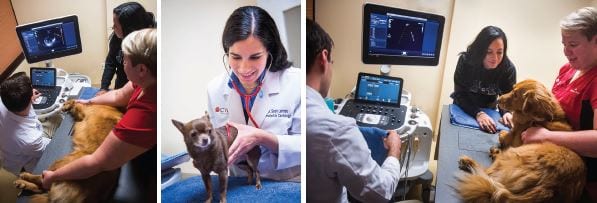The Role of Ultrasound and CT Scan in Modern Veterinary Practices: Insights From Experienced Professionals
In modern-day vet methods, ultrasound and CT scans substantially improve diagnostic abilities. These imaging methods offer vital understandings right into animal wellness, guiding therapy choices. Experienced specialists acknowledge the distinct benefits of each modality. Ultrasound uses real-time assessments, while CT checks provide elaborate physiological information. Comprehending their roles and applications elevates crucial concerns about their effect on person end results and the future of veterinary diagnostics. What insights can be gained from their integrated use?
Recognizing Ultrasound in Vet Medicine
Ultrasound is an essential analysis tool in veterinary medicine, offering a non-invasive approach to picture inner structures. This imaging strategy utilizes high-frequency sound waves to produce real-time pictures of cells and organs, allowing veterinarians to analyze conditions without surgical treatment. Typical applications include reviewing the heart, liver, kidneys, and reproductive organs, as well as keeping track of pregnancies.The procedure is reasonably fast and can be done in different settings, making it an available choice for veterinarians. Unlike radiography, ultrasound provides thorough info regarding soft tissues and blood circulation, which is crucial for precise diagnoses.Veterinary professionals rely upon ultrasound to discover abnormalities such as growths, cysts, and liquid build-up. Its ability to lead biopsies and other treatments further enhances its energy in scientific practice. By supplying a effective and secure method to check out internal composition, ultrasound has actually become a keystone of modern veterinary diagnostics.
The Advantages of CT Scans for Animal Diagnostics
CT checks offer substantial advantages in veterinary diagnostics by providing improved precision in recognizing internal conditions (CT Scans For Dogs). As a non-invasive imaging technique, they ensure the safety and comfort of pets during examinations. In addition, CT scans help with an extensive analysis of interior frameworks, permitting for extra reliable treatment planning
Improved Analysis Accuracy
Developments in imaging modern technology have considerably boosted analysis accuracy in veterinary medicine, especially via the use of CT scans. These scans provide comprehensive cross-sectional photos of an animal's inner structures, permitting vets to identify irregularities with accuracy. The high resolution and three-dimensional capabilities of CT imaging assist in the discovery of conditions such as tumors, fractures, and interior bleeding that may be missed out on with typical imaging approaches. In addition, CT scans can aid in pre-surgical preparation by supplying an extensive view of anatomical connections. This level of detail not only improves the precision of diagnoses but also aids in tailoring effective treatment plans. Consequently, the integration of CT innovation into veterinary practices is transforming the landscape of animal medical care, boosting end results for people.
Non-Invasive Imaging Method
The introduction of non-invasive imaging strategies has actually changed pet diagnostics, with CT checks becoming a prominent device in veterinary methods. These scans provide high-resolution, cross-sectional photos of a pet's interior structures, allowing vets to analyze complex problems without the requirement for invasive treatments. The benefits of CT scans include their capability to identify growths, fractures, and interior blood loss with exceptional precision. Additionally, they promote the examination of soft tissues and organs, boosting diagnostic capabilities. The rate of CT scanning enables fast decision-making, which is important in emergency scenarios. By reducing stress and pain for the animal, CT scans add to a more humane approach to diagnostics, inevitably enhancing therapy results and advancing veterinary care.
Comprehensive Internal Analysis
An extensive internal analysis is vital for exact diagnosis and reliable therapy in vet medicine. CT scans deal significant advantages hereof, supplying detailed cross-sectional pictures of a pet's internal structures. This sophisticated imaging method enhances visualization of complicated anatomical regions, enabling vets to determine problems such as tumors, fractures, and inner blood loss with better precision. Furthermore, CT checks promote the assessment of conditions that may be testing to detect via conventional techniques. The rate and precision of CT imaging also contribute to timely interventions, enhancing individual end results. As veterinary practices increasingly integrate CT modern technology, the advantages of extensive internal assessments end up being apparent, reinforcing the value of this device in modern-day vet diagnostics.
Comparing Ultrasound and CT Imaging Techniques
While both ultrasound and CT imaging serve essential functions in veterinary diagnostics, each method provides distinct advantages and constraints that can influence medical decision-making. Ultrasound is especially valued for its real-time imaging abilities, allowing vets to observe vibrant physical procedures. This method is non-invasive, portable, and does not involve ionizing radiation, making it a safer option for both pets and clinicians. Nonetheless, ultrasound may have constraints in envisioning specific physiological structures or deep tissues.Conversely, CT imaging offers comprehensive cross-sectional views of the body, permitting precise localization of abnormalities. It excels in evaluating facility organs and frameworks, especially in the thorax and abdominal area. Nevertheless, CT scans require sedation or anesthesia oftentimes and involve direct exposure to ionizing radiation. Inevitably, the option between ultrasound and CT depends on the particular medical circumstance, the location of passion, and the urgency of the diagnostic needs.
Situation Researches: Effective Diagnoses Through Imaging
Study highlight the significant renovations in analysis precision achieved through sophisticated imaging technologies like ultrasound and CT scans in veterinary methods. These developments not only enhance the discovery of various conditions yet additionally facilitate effective and timely therapy strategies. Analyzing certain instances can highlight the transformative impact of these imaging techniques on vet medication.
Analysis Precision Improvements

Imaging Modern Technology Advancements
As veterinary imaging technology remains to advance, its impact on analysis capacities comes to be progressively noticeable. Recent study highlight the effective application of sophisticated ultrasound and CT check strategies in recognizing complicated conditions. A veterinary clinic made use of high-resolution CT scans to identify a rare type of lung cancer in a canine, which conventional imaging had actually missed out on. Likewise, an ultrasound evaluation revealed a stomach mass in a feline, prompting prompt medical intervention and a favorable result. additional reading These advancements not just improve diagnostic accuracy however likewise allow veterinarians to devise targeted therapy plans. By leveraging sophisticated imaging modern technologies, veterinary specialists are markedly boosting client treatment, causing more reliable administration of numerous health and wellness problems in check out here animals.
The Role of Imaging in Emergency Vet Care
Imaging plays an important duty in emergency vet care, supplying veterinarians with crucial details needed to make quick, informed choices. In urgent scenarios, techniques like ultrasound and CT scans make it possible for specialists to promptly evaluate a pet dog's internal structures, recognizing crucial problems such as inner bleeding, fractures, or body organ problems. These imaging modalities permit real-time analyses, helping with timely treatments that can be life-saving. For circumstances, ultrasound is indispensable for reviewing soft tissue injuries and conditions like fluid accumulation, while CT scans deal in-depth pictures of intricate physiological structures, vital for detecting injury cases. The rate and precision of these imaging strategies boost the vet's ability to devise effective treatment strategies, ensuring the best feasible end results for their patients. Subsequently, the assimilation of innovative imaging modern technologies right into emergency situation vet methods is not only useful however increasingly required, as it improves analysis capacities and improves overall pet treatment during crucial moments.
Training and Expertise in Veterinary Imaging
Although advanced imaging strategies such as ultrasound and CT scans are vital for reliable veterinary treatment, the effective implementation of these innovations greatly depends upon the training and expertise of veterinary specialists. Skillful use of imaging tools calls for extensive expertise of anatomy, pathology, and the concepts underlying each modality. Veterinary experts have to undertake specialized training to properly interpret imaging results, which is vital for identifying conditions and preparing treatment.Certifications and proceeding education and learning in veterinary imaging enhance the skills of professionals, enabling them to remain updated with technical advancements. Collaboration between veterinarians and radiologists typically brings about boosted analysis precision, as professionals can give understandings right into intricate instances. On top of that, practical experience in handling imaging tools cultivates self-confidence in its application. Inevitably, the top quality of vet imaging solutions is directly correlated to the level of training and competence possessed by the experts utilizing these necessary diagnostic tools.
Future Trends in Diagnostic Imaging for Animals
With the quick innovations in modern technology, vet analysis imaging is poised for considerable evolution in the coming years. Arising trends show a change towards even more mobile and easily accessible imaging modalities, such as portable ultrasound gadgets, which could boost area diagnostics. Furthermore, the integration of expert system is expected to revolutionize picture evaluation, permitting quicker and a lot more precise interpretations of results.Moreover, improvements in 3D imaging methods and calculated tomography will certainly offer vets with more thorough sights of animal makeup, resulting in improved therapy strategies. Virtual truth innovation might also play a duty in medical planning and education, offering veterinarians an one-of-a-kind point of view on intricate cases.As this link telemedicine remains to grow, remote appointments assisted in by analysis imaging will end up being more typical, allowing specialists to aid general professionals in real-time. Overall, these patterns are established to improve the performance and performance of veterinary care, eventually improving animal end results.
Regularly Asked Questions
Exactly How Much Do Ultrasound and CT Checks Cost in Veterinary Clinics?
The expenses of ultrasound and CT scans in veterinary centers generally range from $300 to $1,500, depending upon variables such as area, clinic kind, and details treatments required for the pet's medical diagnosis and therapy.

Are There Any Kind Of Threats Associated With Ultrasound and CT Scans for Animals?
Ultrasound and CT scans normally pose very little dangers to animals. Nevertheless, prospective worries consist of sedation reactions and direct exposure to anesthetics. CT Scans For Dogs. Vets very carefully assess each situation to mitigate any type of threats connected with these analysis treatments
Exactly How Lengthy Do Ultrasound and CT Treatments Usually Take?
Ultrasound procedures typically take around half an hour to an hour, relying on the complexity. CT scans, being more thorough, usually call for thirty minutes to 90 minutes, consisting of prep work and recuperation time for the animal.
Can All Veterinarians Perform Ultrasounds and CT Scans?
Not all veterinarians can perform ultrasounds and CT scans. Specialized training and qualification are frequently required to ensure expertise in these advanced imaging techniques, which may limit their schedule to veterinarians with extra certifications and sources.
What Sorts Of Animals Profit The Majority Of From These Imaging Techniques?
Certain animal species, especially canines and pet cats, advantage considerably from ultrasound and CT scans. These imaging methods improve diagnostic precision for problems like tumors, interior injuries, and organ abnormalities, resulting in enhanced therapy results and patient treatment. The high resolution and three-dimensional capabilities of CT imaging help with the detection of problems such as lumps, fractures, and interior bleeding that could be missed with conventional imaging approaches. Situation research studies illustrate the considerable enhancements in analysis precision accomplished via sophisticated imaging technologies like ultrasound and CT scans in vet methods. Improving diagnostic precision in vet practices has been substantially helped by developments in imaging technologies such as ultrasound and CT scans. Sophisticated imaging techniques such as ultrasound and CT scans are important for reliable veterinary care, the effective execution of these modern technologies heavily depends on the training and knowledge of veterinary experts. Vet experts need to undergo specialized training to properly translate imaging outcomes, which is essential for detecting conditions and intending treatment.Certifications and proceeding education and learning in veterinary imaging boost the abilities of specialists, enabling them to stay upgraded with technological improvements.